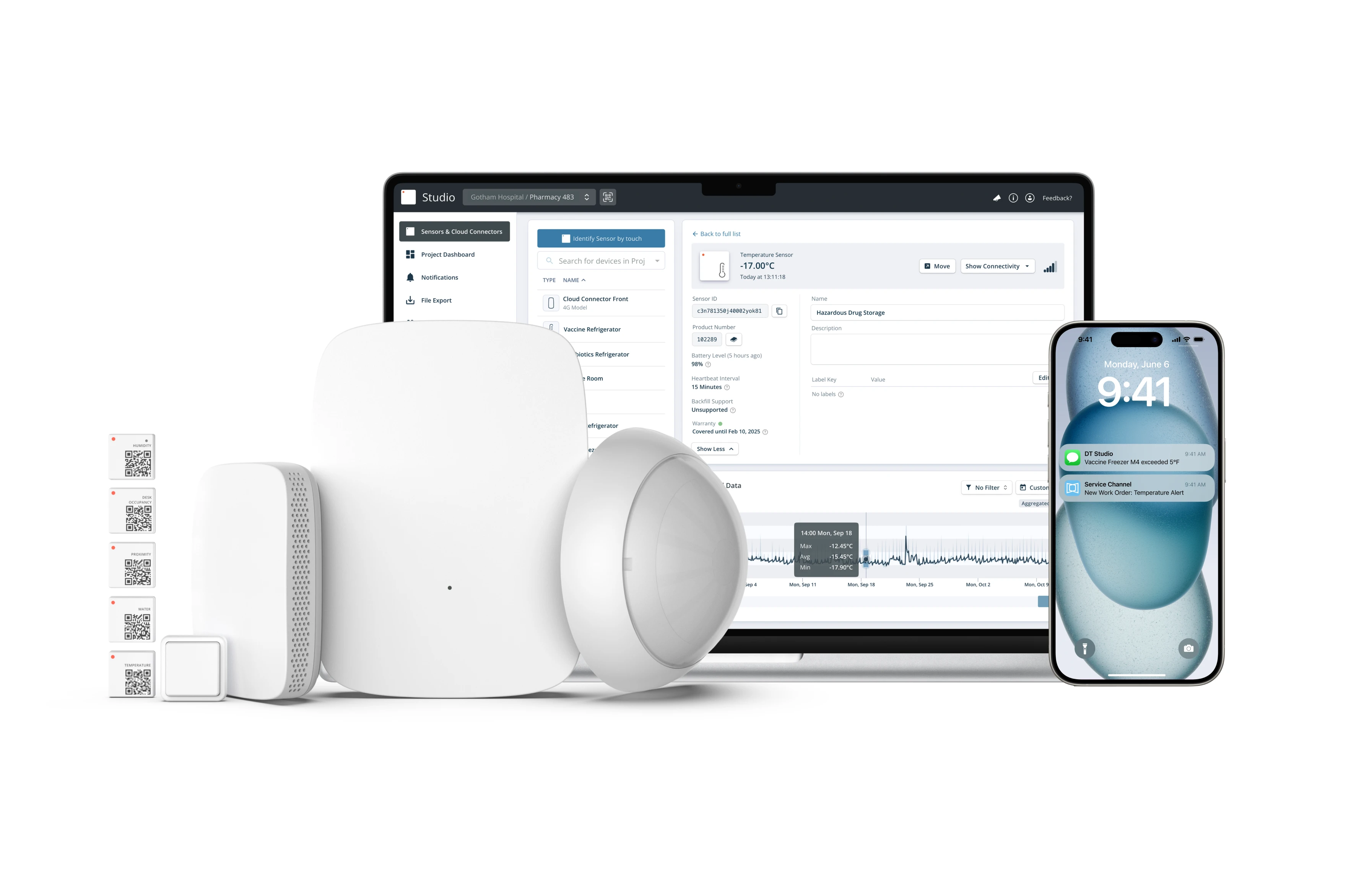How To Improve Food Safety Programs With Sensor Technology

What Are Food Safety Programs?
Food safety programs are systems and procedures put in place to ensure that food products are safe for consumption. They aim to prevent foodborne illnesses by identifying and controlling hazards that may occur at any stage of the food production process.
A foodborne hazard is a biological, chemical, or physical agent in, or condition of, food with the potential to cause adverse health effects (Codex Alimentarius Commission).
- Biological hazards occur when food becomes contaminated by microorganisms found in the air, food, water, soil, animals, and the human body. They include bacteria, molds, viruses, and parasites.
- Chemical hazards can occur at any point during harvesting, storage, preparation, and service. They may consist of naturally-occurring toxins in food, environmental pollutants, production aids, or compounds found during cooking.
- Physical hazards result from accidental contamination or poor food handling practices. They may consist of pieces of hard or sharp parts of food, parts broken off from packaging materials, utensils, or humans, such as hair, nails, etc.
There are several different types of food safety programs used by food manufacturers, processors, and retailers around the world.
Hazard Analysis and Critical Control Points (HACCP), an internationally-recognized systematic approach to the identification, evaluation, and control of food safety hazards, acts as the foundation for every one of them.
While its requirements for implementation may vary from one country to another, HACCP is required by law in many of them.
Simply put, HACCP outlines how an organization that handles food products can demonstrate to its customers, the public, and regulatory agencies that it has the capacity, resources, and commitment to effectively manage food safety.
Where Does HACCP Apply?
In the United States, HACCP is a voluntary process for most food businesses. However, several operations under the HACCP system are considered critical to maintaining food safety. As a result, this approach is highly preferred and recommended by many food agencies and health inspectors.
In contrast, when it comes to meat and poultry food operations, HACCP is required by the US Department of Agriculture Food Safety and Inspection Service (USDA FSIS). Likewise, the US Food and Drug Administration (FDA) mandates the implementation of HACCP in food manufacturing plants of juice and seafood products.
Meanwhile, according to EU regulation (EC) No 852/2004, all food businesses in the European Union, regardless of size or type, are required to implement monitoring systems that are built on the principles of HACCP. This includes all establishments that carry out the production, processing, distribution, and placing on the market of food products.
The HACCP Principles
Businesses looking to manage food safety by implementing monitoring systems under the principles of HACCP must:
- Review every step of the food production process to evaluate potential hazards and establish control measures.
- Identify complete and accurate critical control points (CCPs) located at any step where hazards can be prevented, eliminated, or reduced to acceptable levels.
- Establish critical limits, i.e. maximum and minimum levels to which a parameter must be controlled at a CCP.
- Monitor CCPs on a continuous basis through effective procedures to determine when there is a loss of control or a deviation occurs. At this stage, monitoring equipment must be carefully calibrated for accuracy.
- Develop corrective actions in case of a deviation from established critical limits (Step 3).
- Establish verification procedures that determine the system is operating according to plan.
- Establish record-keeping and documentation procedures.
HACCP takes place as the continuous monitoring of CCPs and the periodic control of the system in place. This could mean audits, sampling, testing or trend analysis, or other measures that can reveal the success or failure of the system.
Maintaining The Cold Chain
For all food businesses, a major aspect of implementing HACCP is ensuring that perishable goods are held and displayed at the correct temperature throughout the cold chain.
This requires continuous monitoring and control of temperatures at all stages in the supply chain of food products. From their processing, storage, and transport, to their placement on the shelves of the commercial premises where the customer acquires them - or “from farm to fork,” it is necessary to:
- Hermetically package the food products
- Store them in specific cold rooms
- Keep them at a constant and appropriate temperature
- Use specialized transport
- Measure and control temperatures throughout the chain
This process involves a number of entities, as well as physical and technological infrastructure, mainly cold rooms, industrial freezers, adapted vehicles, refrigerated displays, etc.
Two of the methods to maintain and guarantee the cold chain are refrigeration and freezing:
- At refrigeration, food preservation is achieved at a low temperature, but without reaching degrees of freezing below 0ºC (32ºF).
- Most types of food that require freezing are stored at temperatures between -18 and -35ºC (-0.4 and -31ºF).
Failing to maintain the cold chain due to equipment deterioration or breakage can cause the spoilage of perishable goods pre- or post-production, leading to added replacement or disposal costs for businesses and supply chain partners.
As a result, remotely maintaining the cold chain on a continuous basis through monitoring devices and temperature analysis is critical. These tools detect issues before they occur, preventing business disruptions and added operational costs.
Temperature Monitoring of Cold Storage Conditions
In retail and food service businesses, HACCP plans are put in place to protect consumers from any hazards that may find their way into the cooling equipment of grocery stores, convenience stores, or restaurants.
The owners of these establishments often have a number of fridges, refrigerated displays, freezers, and cold rooms, of which they need to maintain a strict level of control when foods are being stored.
Temperature monitoring is the safest way to keep food fresh and ensure equipment is working at the correct capacity. The 0 to 10ºC range is the most common for fresh foods since the microbial process in it is very slow. In contrast, food in the “danger zone,” or between 4.5ºC (40ºF) and 60ºC (140ºF) is susceptible to rapid bacterial growth.
Even if the food doesn’t become unsafe, suboptimal conditions undetected by the naked eye, like system malfunctions, may cause its appearance or taste to change. This can lead to food waste just as much as bacterial growth because customers often don’t want to buy products that are in less than perfect condition.
Under HACCP plans, temperature monitoring in this sector typically involves employees:
- Manually checking thermometers inside each cooling unit that are meant to reflect the internal product temperature
- Calibrating monitoring devices for accuracy, so that operational issues are detected and resolved
- Documenting issue detection and ensuing corrective action
However, temperature monitoring isn’t effective if the monitoring devices are inaccurate or lacking calibration. An inaccurate device could lead to an incorrect temperature reading, enough to allow for the growth of bacteria and spoilage of food.
Also, if the instruments are too hard to use or read, implementing them without the proper employee training won’t be very effective.
Overall, these procedures are time and resource-consuming, prone to human error, and take the focus off other critical tasks. In response, cost-effective and easy-to-use remote monitoring devices that improve accuracy with HACCP compliance logging and corrective actions should be considered.
Upgrading HACCP Plans With Help From Modern Technology

A HACCP plan will work even better when coupled with the best monitoring tools and solutions available on the market.
Internet of Things (IoT) solutions based on sensor technology have the potential to significantly improve any food safety program by enabling real-time, 24/7 remote monitoring of the temperature, humidity, and other conditions of equipment throughout the cold chain.
Cold Storage Monitoring Through IoT Sensors Has Many Benefits
In the retail and food service sector, these solutions will improve operational visibility and productivity in food establishments and quality control of products. Specifically, remote temperature monitoring based on IoT sensor technology allows businesses to:
- Reduce potential human error from manual checks, streamlining the manual equipment monitoring process.
- Receive timely alerts if any equipment is malfunctioning or any food temperature has changed for any reason, enabling corrective action.
- Improve overall resource efficiency and business continuity.
- Monitor critical limits on a continuous basis, meeting Step 4 of HACCP compliance.
- Document all measurements to the cloud by providing a complete record of data for review and inspection, meeting Step 7 of HACCP compliance.
- Redirect employees to focus on other critical tasks, such as excellent customer service.
- Exhibit a commitment to food safety, enhancing customer satisfaction.
Our Wireless Temperature Sensor with Data Backfill

At Disruptive Technologies, we are introducing the new wireless temperature sensor with data backfill, a game-changing technology that is meant to revolutionize the way temperature data is currently collected and used in the industry.
Data backfill is the ability of our new sensor to store up to 100,000 temperature samples internally if the cloud connection is lost. This ensures that critical data is never lost, even in the event of a temporary disruption in connectivity. This feature is particularly important for regulatory compliance, as it ensures that customers always have a complete record of historical data available for HACCP compliance logging.
Ideal for continuous temperature monitoring in a variety of settings in the retail and food service sector, such as grocery stores, convenience stores, and restaurants, the wireless temperature sensor with data backfill can help businesses stay on top of HACCP compliance, reduce food waste, optimize energy consumption, and reduce the resources required to monitor equipment manually.

Temperature Monitoring Made Simple
Get Started





